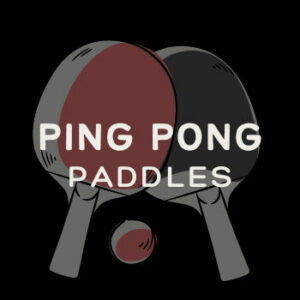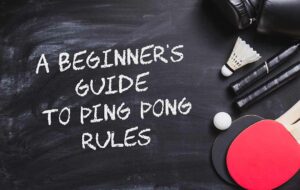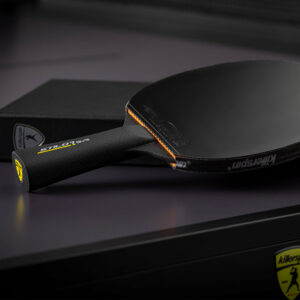How to choose a table tennis racket: A brief guide
How to choose a table tennis racket that is right for you is crucial for any player, whether you’re a beginner or a seasoned professional.
With so many options available in the market, it can be overwhelming to know where to start.
In this comprehensive guide, we will take you through the key factors to consider when choosing a table tennis racket.
By the end, you’ll be well-equipped to make an informed decision that will enhance your performance on the table.
Evaluating the Different Types of Rackets
When it comes to table tennis, finding the perfect racket is crucial for enhancing your gameplay.
So how to choose a table tennis racket? With so many options available, it’s important to understand the different types of rackets and their unique characteristics.
Let’s delve deeper into the world of table tennis rackets and explore the three broad categories: Speed-oriented, Control-oriented, and All-round rackets.
Rule Ping Pongs top picks for ping pong paddles:
| Product | Playstyle | Suitability | Link |
|---|---|---|---|
| Palio Expert 2 | All-rounder | Beginners | Check price |
| JOOLA Infinity Balance | All-rounder | Intermediate players | Check price |
| Stiga Pro Carbon | More attacking playstyle | Intermediate players | Check price |
| Killerspin Jet800 Speed N2 | More defensive playstyle | Intermediate players | Check price |
Want to see our top 10 picks for ping pong paddles for beginners? Click here.
So how do I choose the right ping pong paddle for me?
Speed-oriented rackets are specifically designed for players who rely on powerful strokes and aggressive play.
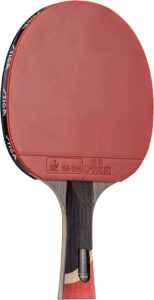
These rackets are built to generate maximum speed and spin, allowing players to dominate the game with their attacking style.
Typically, speed-oriented rackets have a heavier weight and a thick blade.
The advantage of a thick blade is that it provides a larger sweet spot, which means you have a greater chance of making successful shots even if you don’t hit the ball perfectly.
This feature can be a game-changer, especially in intense matches where split-second decisions can make all the difference.
On the other hand, control-oriented rackets prioritize precision and accuracy.
These rackets are designed for players who value finesse and want to have better control over the ball.
Control-oriented rackets usually have a thinner blade and lighter weight, allowing players to maneuver the racket with ease.
The thinner blade enables players to feel the ball better, resulting in improved touch and accuracy.
With a control-oriented racket, you can execute precise shots, strategically place the ball, and outmaneuver your opponents.
For players who prefer a versatile playing style and want a racket that can adapt to various gameplay situations, all-round rackets are the way to go.
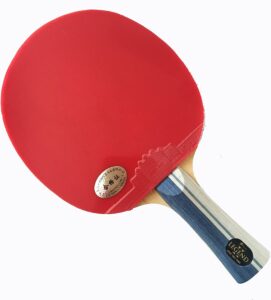
These rackets strike a balance between speed and control, making them suitable for players of all skill levels.
Whether you’re a beginner trying to find your playing style or an experienced player who enjoys mixing up your shots, an all-round racket can be your best companion on the table tennis court.
With an all-round racket, you can switch between attacking and defensive strategies effortlessly, giving you an edge over your opponents.
When evaluating the different types of rackets, it’s important to consider your playing style and skill level.
Are you an aggressive player who relies on powerful strokes, or do you prefer a more controlled and precise approach?
Understanding your strengths and weaknesses will help you make an informed decision and choose a racket that complements your playing style.
Additionally, consider factors such as grip type, blade composition, and rubber type, as these elements can further enhance your gameplay experience.
So, whether you’re a speed demon, a precision artist, or an all-round player, there’s a table tennis racket out there that suits your needs.
so when asked how to choose a table tennis racket, take your time to explore the different types of rackets, try them out, and find the one that feels like an extension of your arm.
With the right racket in your hand, you’ll be able to unleash your full potential and take your table tennis skills to new heights!
Understanding the Different Materials Used in Racket Construction
When answering how to choose a table tennis racket, the material used in the construction of a table tennis racket plays a significant role in its performance.
The blade, which is the main body of the racket, is usually made of wood.

Wood is a popular choice due to its natural feel and responsiveness.
Different types of wood, such as hinoki, limba, and koto, offer varying levels of speed and control.
Some advanced rackets may also incorporate carbon or fiberglass layers to enhance speed and control even further.
When it comes to the rubber sheet on the racket’s surface, you have two options: pimpled rubber or smooth rubber.
Pimpled rubber, also known as “pips-out” rubber, has small pimples on the surface.
This type of rubber provides better grip and control, making it suitable for defensive players who rely on placement and consistency.
Pimpled rubber also allows for more variation in spin, making it harder for opponents to predict the trajectory of the ball.
On the other hand, smooth rubber has a flat surface without any pimples.
This type of rubber allows for more spin and speed, perfect for offensive players who rely on aggressive shots and powerful strokes.
Smooth rubber provides a greater ability to generate topspin and backspin, enabling players to create more challenging shots that can catch opponents off guard.
Consider your style of play and personal preferences when selecting the material for your racket.
Experimenting with different combinations of blade and rubber can help you find the right balance between speed, control, and spin.
It’s important to note that finding the perfect racket is a highly individual process, as each player has unique strengths and playing styles.
In addition to the blade and rubber, other factors can also affect the overall performance of a table tennis racket.
The handle, for example, plays a crucial role in providing comfort and stability during play.
Racket handles come in various shapes and sizes, including straight, flared, and anatomical.
Each handle shape offers a different feel and grip, allowing players to choose the one that suits them best.
Furthermore, the thickness of the blade and the sponge used in the rubber can also impact the racket’s performance.
Thicker blades generally offer more power and stability, while thinner blades provide better control and touch.
The sponge, which is located between the blade and the rubber, can vary in hardness and thickness, affecting the racket’s speed and feel.
It’s worth noting that the International Table Tennis Federation (ITTF) has specific regulations regarding racket construction.
The blade must be made of at least 85% natural wood, and the rubber must have specific characteristics and thickness limits.
These regulations ensure fairness and standardization in competitive play.
In conclusion, understanding the different materials used in racket construction is essential for table tennis players looking to optimize their performance.
By considering factors such as the blade, rubber, handle, and other components, players can tailor their racket to suit their playing style and preferences.
Experimentation and practice with different combinations will ultimately lead to finding the perfect racket that enhances your skills and enjoyment of the game.
Assessing the Weight and Balance of the Racket
The weight and balance of a table tennis racket are critical factors on how to choose a table tennis racket that can greatly affect your gameplay.
Rackets come in a range of weights, typically ranging from 70-100 grams.
Lighter rackets are easier to maneuver and provide better control, while heavier rackets offer more power and stability.
The balance of the racket refers to the distribution of weight between the handle and the blade.
Rackets can be categorized as head-heavy, even-balanced, or head-light.
Head-heavy rackets provide more power in your shots but can be less maneuverable.
Head-light rackets offer better control but may sacrifice some power.
Try different racket weights and balances to determine which combination feels most comfortable and suits your playing style.
Consider any physical limitations or preferences you may have, as they can impact your ability to handle a heavier racket.
Comparing the Different Types of Grip
The grip of a table tennis racket is often overlooked but is crucial for maintaining control and comfort during gameplay.
There are two main types of grip: Shakehand grip and Penhold grip.
The Shakehand grip is the most commonly used grip in table tennis.
It involves holding the racket as if shaking someone’s hand, with all fingers wrapped around the handle.
The Penhold grip, on the other hand, involves holding the racket as if holding a pen, with the thumb and forefinger gripping the handle and the remaining fingers resting on the blade.
Both grips have their advantages and disadvantages, and the choice ultimately comes down to personal preference.
Experiment with both grips and choose the one that feels most natural and comfortable for you.
Identifying the Ideal Playing Style for Your Racket
As you evaluate the different factors mentioned above, it’s important to keep your ideal playing style in mind.
Your playing style might be offensive, defensive, or a combination of both.
Defensive players prioritize control and accuracy, while offensive players focus on speed and spin.
An all-round playing style requires a racket that offers a balance between speed and control.
Consider the strengths and weaknesses of your playing style and choose a racket that complements your skills.
In conclusion, after learning on how to choose a table tennis racket, choosing a racket requires careful consideration of various factors such as the type of racket, material composition, weight and balance, grip type, and your playing style.
Keep in mind that the right racket for you may not be the same as someone else.
Take the time to test different rackets, seek advice from experts, and most importantly, trust your own judgment.
Hopefully our guide here at Rule Ping Pong helps you choose a well-suited racket that can greatly enhance your performance and enjoyment on the table, so choose wisely and play your best game!
